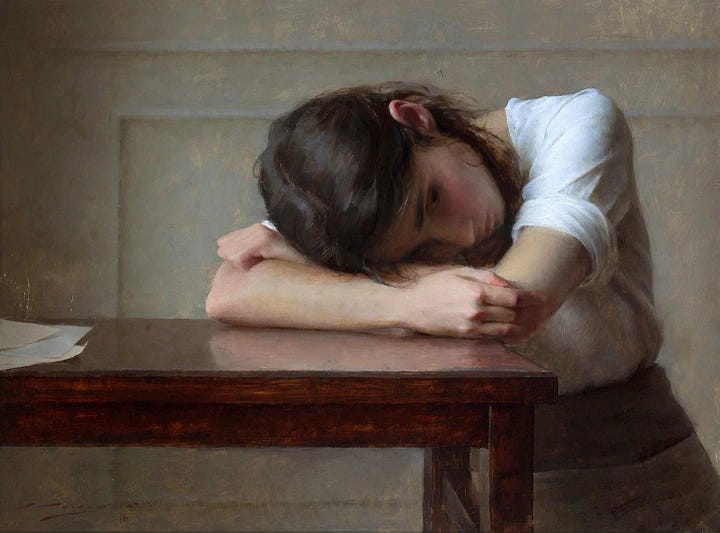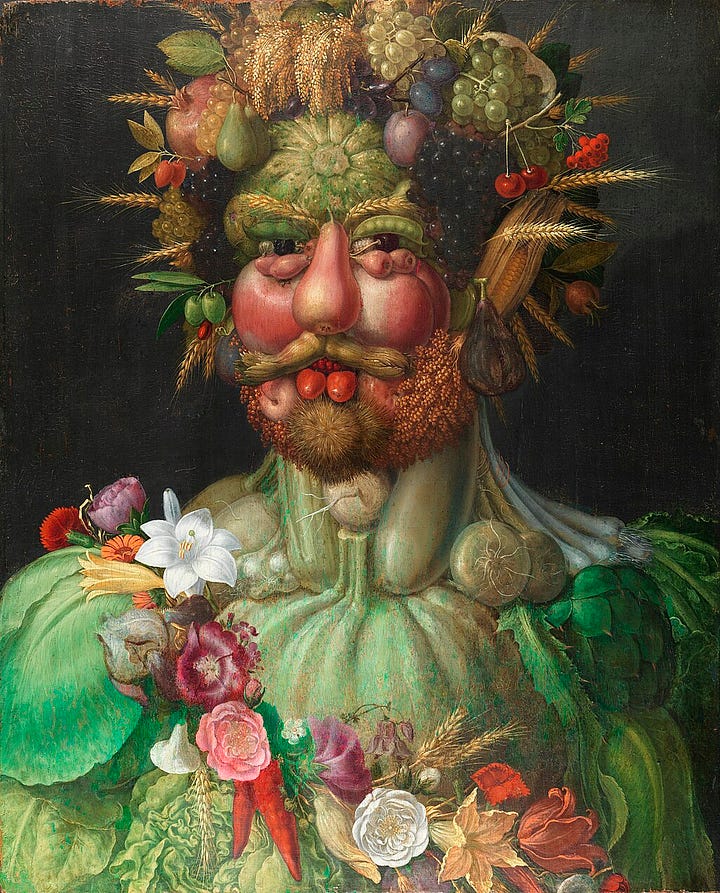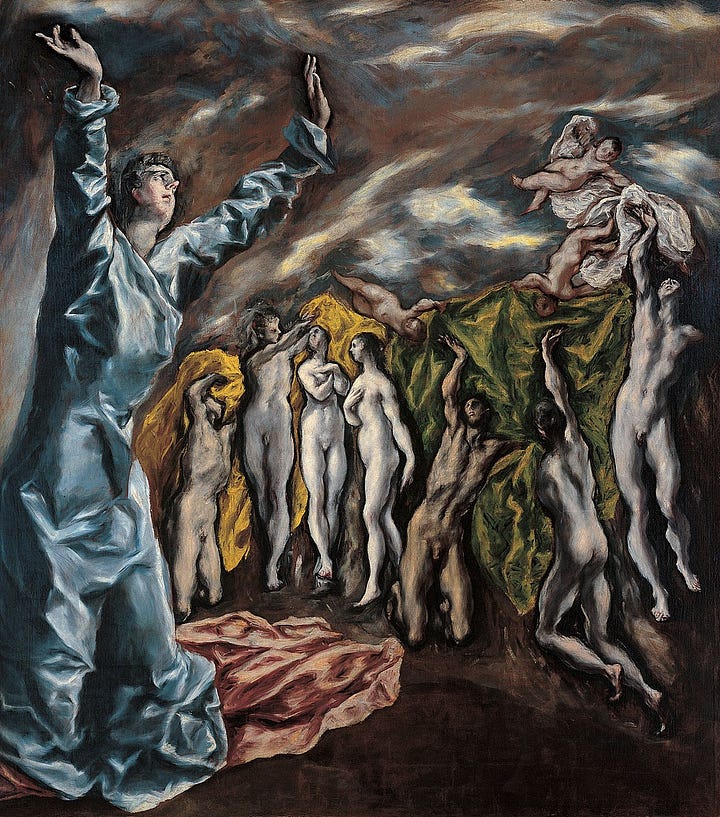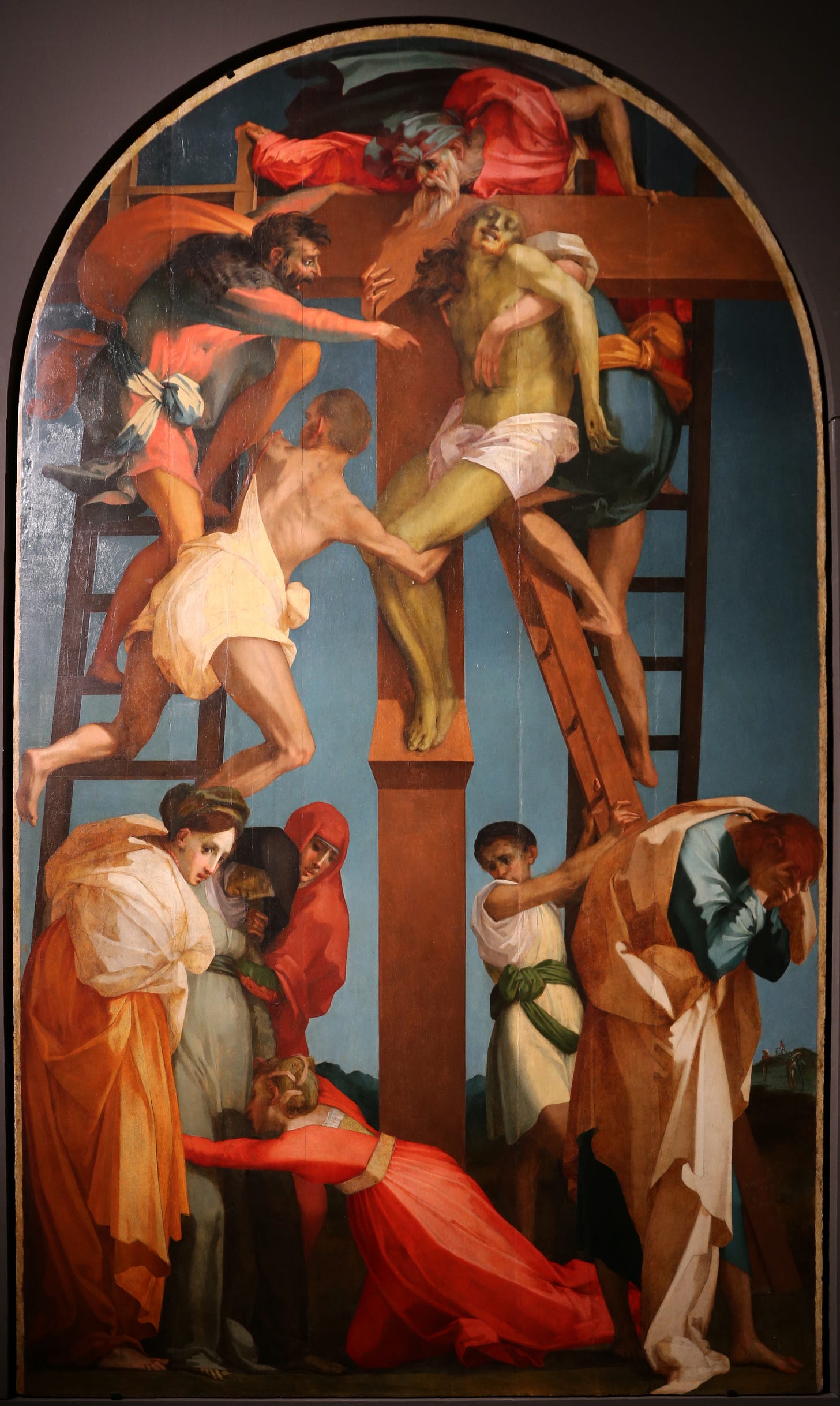I paywalled some good stuff yesterday and I wanted to return to one point that was hidden, which is the text of Luke 5:37-39:
And no one pours new wine into old wineskins. Otherwise, the new wine will burst the skins; the wine will run out and the wineskins will be ruined. No, new wine must be poured into new wineskins. And no one after drinking old wine wants the new, for they say, ‘The old is better.’”
I cited the text to support my claim that Christianity, at least at its onset, was not a traditional, but a novel, phenomenon. It was radical, disruptive, and yes—even liberating. I’ll return to these claims to support them a bit again today, but let me get ahead of you first.
It is only Catholics who will object to my reading of these verses. Knowing that (it’s easy to anticipate), I sit down and G0ogle “Catholic commentary on scripture by verse.” Pretty natural, right? The first hit says “try the Catena Bible app.” Okay… I am very familiar with that app and have it on my phone. It has commentaries from church fathers on almost every verse in the Bible—usually multiple commentaries from multiple men on each verse. On Luke 5:37 & 38? Nothing. On 39, one comment from Cyril of Alexandria:
Those who live according to the law cannot receive the institutions of Christ. These institutions cannot be admitted into the hearts of such as have not as yet received the renewing by the Holy Spirit. The Lord shows this by saying that a tattered patch cannot be put upon a new garment, nor can old skins hold new wine. The first covenant has grown old, nor was it free from fault. Those, therefore, who adhere to it and keep at heart the antiquated commandment have no share in the new order of things in Christ. In him all things are become new, but their mind being decayed, they have no harmony or point of mutual agreement with the ministers of the new covenant.
—Commentary on Luke, Homilies
Well, yeah. I agree with that. I might emphasize certain points a little more, uh, emphatically—but Cyril gets it right. Still, there must be more Catholic commentary. The next hit on Go0gle takes me to a reddit thread asking “what's the best website for authentic catholic verse-by-verse bible commentary?”
The only other online commentary I can find is the Haydock commentary. I go to Luke 5… it simply skips these verses. Nothing to say, huh Haydock? Really?
Perhaps I’m missing other Catholic commentaries. But it should be beside the point, in my opinion. This is one of Jesus’ clearest parables. It is *obviously* plainly and explicitly about the incompatibility of the old with the new. The same parable with slightly different inflection is given in Matthew 9:
No one sews a patch of unshrunk cloth on an old garment, for the patch will pull away from the garment, making the tear worse. Neither do people pour new wine into old wineskins. If they do, the skins will burst; the wine will run out and the wineskins will be ruined. No, they pour new wine into new wineskins, and both are preserved.
A quick reminder here that McGilchrist showed us a couple weeks ago that the left-brain literally cannot understand analogies. You have to go right-brained to understand the parables of Jesus. That’s pretty interesting in and of itself, isn’t it? Mark the evangelist even reports that “[Jesus] did not say anything to them without using a parable.”
There is nothing hidden or unclear about the meaning of this particular parable unless you refuse to come over into the right-brain style. Then you’ll have the blind spot, as the Pharisees did.
I remember this one time about six years ago I made my fourth grade daughter do chess club at her school and she went to a couple tournaments. These were extreme chess beginners. The first tourney we went to, I watched through a window as my daughter checkmated this drooling little moron. It got to the point where, if she had more experience, she would have proudly slammed her piece down and said “checkmate,” and stood up—not looking back.
But she played the checkmate move and then just sat there. And then the kid just… made an illegal move that made no sense. I watched my daughter look at the kid with confusion. She looked over at me. I couldn’t resist trying to mouth to her “check mate!”
What am I saying here? First, I’m once again inviting you into the right-brain mode by talking in analogy. But also: I’m saying this particular parable of Jesus simply can’t be squared with the “trad” narrative that has become popular in right-wing Christian/Catholic circles. But they just won’t admit that. They just play a bizarre and illegal move and pretend checkmate didn’t happen. Classic pilpul, actually!
An honest ten-year old could understand what Jesus is saying. To be clear, the parable illustrates that the gospel is too powerful and new to be contained within the old religious structures, rites, and institutions. To try to squeeze it into the old model would ruin both the new thing and the old thing. Better to give it new digs, so to speak: new institutions, new everything.
I’ve been trying to explain to my friend how I am frustrated by the knee-jerk story told by trads that art and poetry and music have all been trash in the 20th century. My claim is that they simply and irrationally hate new wineskins.
Then problem is (in my view) that traditionalists are afraid to engage non-didactic art at the aesthetic level because that demands discernment and personal judgment. So much safer and easier to just claim that “art has been corrupt and degenerate since 1900”—and then just refer to old paintings and music and poetry as the best (and only) examples of beauty. But what is art? Art, in my view, is our own kind of haruspicy—or it should be. It is the prophets speaking to us. It is how God still moves in the world. To refuse to engage with any post-1900 art is evidence of a kind of mental malfunction—God is not the god of the dead, but of the living!
Look:




And look again:




The story you guys are telling from the trad side of the internet is oversimple, and because of that, it is easy to reveal as untrue. There is lots of good art still being made. But if you insist on art’s goodness being recognizable by old formalisms, you will ruin the new art and the old forms!
If we have Christ, we are new wine. And we must not be held in old wineskins.
Not all painting is Rothko or Pollock. Not all music is John Cage. And poetry? I have yet to meet even one religiously trad person who even reads contemporary poetry—it’s a total waste of my time to argue about it with them! The spirit moves and art is occurring even now, but you are the ones who have tasted old wine and refuse to taste the new.
The real difficulty is with music—where, if you insist on old forms, you can find contemporary musicians returning to those forms (mostly unsuccessfully). Listen to John Tavener or Paul Hillier or Edward Higginbottom if you like that sort of thing. But that’s cramming new wine into old wineskins, in my opinion. The reason the discussion is so difficult is the trads will always point to Brahms or Mozart as the archetypes of “good music,” and that narrows what is allowed. It’s as if they’re not even aware new wineskins are an option.
Poetry is my favorite new wineskin, my favorite contemporary art. I read it all the time, and it frustrates me how quick the religious-traditional people are to throw it all out on the grounds that “it’s just chaos with no form” without even bothering to read any of it! Yes, free verse is a thing now—never mind that such luminaries as T.S. Eliot and Thomas Merton and Catholic convert Denise Levertov all wrote in free verse. But so many living poets don’t write in free verse!
There are those like Diane Seuss who try to cram new wine into old wineskins, writing in the old sonnet form, for instance. But A.E. Stallings (b. 1968), Mary Jo Salter (b. 1954) and the late Elizabeth Bishop, to name just a few, all composed formal poems. Still, this feels like a concession to me, because the goal should not be to force our own experience into old forms. “Behold, I make all things new!”
Now, the caveat to all of this—the final escape hatch for trads—is that you can acknowledge what Jesus said and even concede to me that I read the meaning of his parable correctly, but (then) you can go on to claim that “new wine” only came once, in the figure of Jesus, 2000 years ago. Yes, Christianity accommodated something new, that one time—but it wasn’t supposed to continue doing that.
I acknowledge: that question is harder—just a matter of faith. But I think that’s not right. I think God is the god of the living, and new wineskins must be made in each generation, or the new wine will spill out and be ruined.
The thing is, whatever your complaints about poetry, someone is out there writing poetry the way you would want them to—and you’re not even looking for it or reading it. This is what I mean when I say the right-wing doesn’t have an art-production problem. It has an art-appreciation problem.
The only thing you won’t find is flatly didactic work presented as literary art. Because nobody in their right mind actually wants to read the catechism set to iambic pentameter. That’s not what art is. Perhaps we’ll have to argue about that point too. But I think art has always been understood as something only diagonally related to matters of doctrine. Instead, it is about the cosmic and the personal, and how those things come together—most often in crystallized moments that seem to transcend themselves.
And keep in mind: every form came into existence somewhere as a novelty. Even the sonnet.
With regard to painting: we may talk aloofly all day about the elements of painting and the kinds of things that give it excellence—”skill,” “symmetry,” “color,” “design,” “perspective,” and whatever else. But all of these have always been negotiable. There is no true form except for nature itself—and even that is outstripped sometimes, because the painters have always had recourse to dreams. Not just Paul Delvaux and Salvador Dali, but Fra Angelico too.
Finally, a concluding point: it may even be that the old media themselves — paintings, for instance, or even poems (god forbid), are superseded at some point and replaced by things like film and even YouTube videos, etc. I think you have to try to understand that even something like Rosso Fieorentino’s mannerist paintings of the 16th century (below) were criticized by the conservative/traditionalist critic, Giorgio Vasari, as degenerate. Giovanni Bellori trashed Caravaggio as contributing to a decline of classical beauty. At some point, these kinds of (old) familiar complaints have to make you think twice about the knee-jerk way so many of our contemporaries dismiss all contemporary art. Again: there has always been bad art. I agree: Rothko and Chagall are hacks, okay? But keep digging. There are excellent painters and if painting seems dead to you as a genre, there are excellent movie directors.
Here’s a piece of nearly-contemporary music that I really like—like as much as the Beethoven and Bach that I know. It is certainly different. But we live in different times, don’t we? New wineskins.








You make interesting points, but Jesus' parable was not teaching that he should be received because he was new but because be was alive and they were dead, not because they were traditional. Not everything new is good or better, and not everything old is not bad or worse. The Pharisees were not rejecting Jesus because he was teaching new things but because the had the law wrong. They had built their power base on a bad foundation and Jesus was a threat to their foundation. Their tradition had squeezed the life out of God's revelation to Moses
There was not a fault in the law; God has given it directly to the descendants of Abraham, Jacob, and Israel. How could a gift from God be anything but good? But the Tradition was not what God had given them. God's revelation in the Old Testament was intrusted to Moses and the Jews, like the message of Jesus to the disciples, to be transmitted to the rest of the world, not to be hidden away from everyone else. It was a way back from the death that Adam had brought onto himself and his descendants to a restored life. Jesus said at one point, "I am the resurrection and the life" and John wrote very clearly, "For God so loved the world, that he gave his only begotten Son, that whosoever believeth in him should not perish, but have everlasting life. For God sent not his Son into the world to condemn the world; but that the world through him might be saved."
The Jews had taken the message from God and by their tradition, still oral in the time Jesus was preaching, and turned it into a condemnation. Jesus had taught that the heart of the law was to love God and to Love each other. That was the way back to God. Breaking the law was not why people were dead and dying. They did not love God or each other because they were dead. That is why the must be born again, a message that Nicodemus couldn't understand.
The old wineskin and the old cloak were the teachings of the tradition of the Pharisees. It had nothing to do with the old wine. The old wine was still drinkable, but was still, as opposed to the new wine which was active, still giving off carbon dioxide, which would build up pressure that would burst the old wineskin. Elijah proclaimed after God had approved of his sacrifice and consumed it, "Choose you this day life." That was the old message and the new. Life or death. As Paul taught, the law reveals that we are dead. The gospel reveals that we can have life. In a way, the law kills. Thou shall not covet. Is there anyone who does not covet? That was true in the time of Moses. It is still true today. Ecclesiastes told us there is nothing new under the sun. Jesus came from above the sun, not to condemn the world that is under the sun, but that the world could have everlasting life. That is the new wine that will destroy the old wineskin.
You should consider that not everyone is into poetry. It’s not necessarily a rejection of modern poetry simply because it’s new.
I find it interesting that you apply definite qualitative judgments to art as well. This painting is bad. That one is good. You apply it in an objective sense. So there must be elements that are necessary for successful art. It’s not infinitely open ended.
I think you over state how “trads” are close minded about new art. The term is so unspecific. I’m sure you could find some sspx grouches who say that. But there’s plenty of new art being produced within the church by people who value her traditions. Among others I would point to the Benedict xvi institute for sacred music, which patronizes composers of new music for the liturgy.
I agree with the general reading of the parable of wineskins. But It’s not clear to me what you think the new covenant is. All the other covenants in the Bible were made at particular moment and have specific contents. But I think you are viewing the New Testament covenant as categorically different. You should elaborate on that.